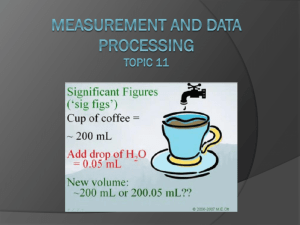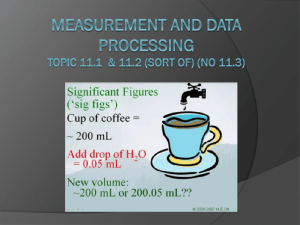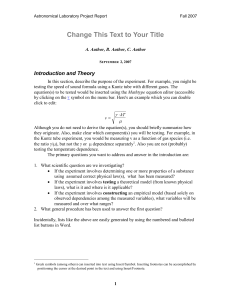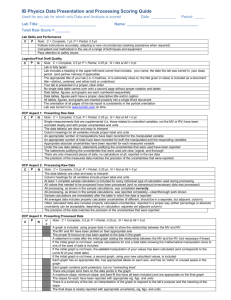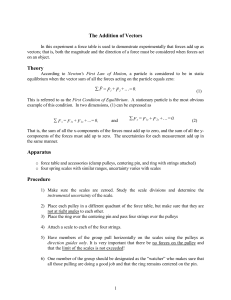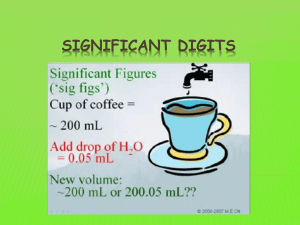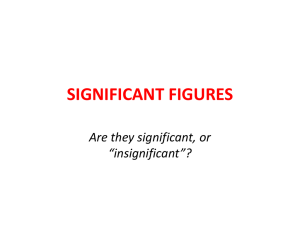Measurement, Error, Sig. Figs. and Error Processing
advertisement
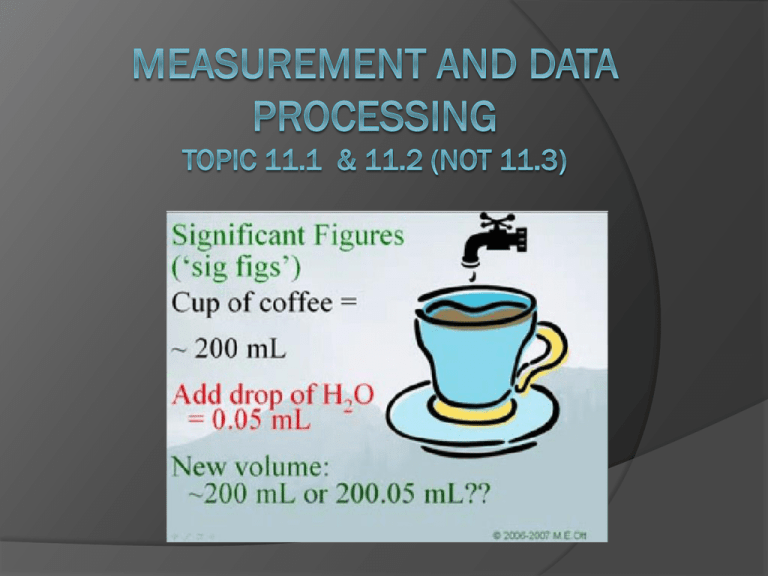
Data Qualitative (don’t forget this in all labs) non-numerical information obtained from observations, not from measurement Quantitative numerical information obtained from measurements ○ always associated with random error/uncertainties Precision vs. Accuracy precision the exactness of a measurement small amount of randomness describes how close together repeated measurements or events are to one another-even if it is wrong accuracy closeness of a measured result to an actual/true value “is the answer correct?” Experimental Error error in a measurement refers to the degree of fluctuation in a measurement types systematic error ○ instrumental, personal, or methodology errors examples- scale not set to zero, thermometer with an air bubble, reading a measurement too high or low… ○ be sure to address if this will have a major or minor effect on final results ○ collecting more data will NOT help I never saw that rock in there. Ooops! I guess my measurement is too high random error ○ a measurement could either be too high OR too low human error in reading equipment environmental error such as fluctuations in equipment, vibrations…. random error no systematic error can be reduced by taking more measurements and finding an average range of random uncertainties (error) ○ digital equipment + or – the smallest division on the equipment - 24.8 ºC could be either 24.7 or 24.9 - smallest division is the tenths place - 24.8 +/- 0.1 ºC ○ analog equipment + or – half the smallest division on the equipment - smallest division is one second - 20.6 sec could be as low as 20.1 sec or as high as 21.1 sec. - 20.6 +/- 0.5 sec Don’t forget in analog equipment you can always estimate the last digit. It is still significant. The 6 was estimated by the person measuring and is NOT the smallest division capable by the equipment 256.15 +/- .05g smallest division is .1 .1/2 = .05 5.55 +/- .05 cm smallest division is .1 .1/2 = .05 smallest division is .01 .01/2 = .005 124.465 +/- .005 g 52.6 +/- .5 ml smallest division is 1 1/2 = .5 Significant Figures sig fig video the numbers that are measured, plus one more number that is estimated Significant figures 1. every nonzero digit- 24.7, 0.743, 714 2. zeros between nonzero digits- 7003, 40.79, 1.503 3. zeros at the end of a number and to the right of a decimal point= 43.00, 1.010, 9.000 Non-significant figures 1. leftmost zeros acting as place holders- 0.0071, .00090 2. rightmost zeros acting as place holders- 300, 7000, 27,210 How would you show 7000 with two sig figs? 7.0 x 103 With four sig figs? 7.000 x 103 or 7000. • • • • best answer is around 2.63 cm to a scientist this number means “between 2.60 and 2.70 cm.” the last digit, 3, representing the smallest amount, is uncertain, but it is still significant always “push it” one more decimal place by estimating Number (m) Significant figures 47.7 3 0.43 2 1.304 4 0.00023 2 8.00 3 300 1 3.00X102 3 https://www.youtube.com/watch?v=eCJ76hz7jPM Significant Figures When Calculating: • Addition and Subtraction – an answer should not be more accurate than your measurements! – the answer should be rounded to the same number of decimal places as the measurement with the least number of decimal places • 22.75 cm + 98.457 cm + 10.1 cm • = 131.307 on your calculator • however, 10.1 cm has the least number of decimal places – therefore, the answer is 131.3 cm Multiplication and Division an answer should not be more accurate than your measurements! the answer should be rounded to the same number of significant figures as the measurement with the least number of significant figures ○ 0.7 m x 98.457 m ○ = 68.9199 m2 on your calculator ○ however, 0.7 m has the least number of significant figures therefore, the answer is 70 m2 Percentage Error % error = [error] X 100% accepted value What is the percent error if the boiling point of water is measured at 99.2° Celsius? % error = 99.2°C- 100.0°C 100.0°C = 0.8°C X 100% 100.0°C = 0.008 X 100% = 0.8% X 100% Uncertainties in calculated results Addition/Subtraction: the maximum uncertainty is the sum of the individual uncertainties add the absolute uncertainties 111.28 + 0.01 g - 101.23 + 0.01 g = 10.05 + 0.02 g 111.29 + 0.01 g - 101.23 + 0.01 g = 10.06 + 0.02 g 111.31 + 0.02 g - 101.23 + 0.02 g = 10.09 + 0.04 g total 30.20 + 0.08g Or, “simply” put…. add up the absolute uncertainties for each measurement and use this with your final answer Multiplication/Division: relative uncertainties have to be used the ratio comparing the size of the absolute uncertainty to the size of measurement the maximum uncertainty is the sum of the % uncertainties for each individual quantity Problem: 2.4 + 0.2 cm x 1.3 + 0.2 cm Steps: 1. divide the absolute uncertainty by the given measurement to give a percentage uncertainty 0.2/2.4 = 0.083 which is 8.3% 0.2/1.3 = 0.154 which is 15.4% 2. % uncertainties can then be added 8.3% +15.4% = 23.7% 3. perform math and then convert percent uncertainty back to an absolute value 2.4 x 1.3 = 3.12 + 23.7% 3.12 x 23.7% = 0.739 3.12 + 0.739 (sig figs) 3.1 + 0.7 cm2 Or, “simply” put…. use absolute uncertainties in order to calculate the percentage uncertainties for each measurement then add up convert back to an absolute uncertainty when you have the final answer (don’t forget sig figs in final answer) (uncertainty can be only one sig fig if it makes you happy) Graphical Techniques (11.2) sketched graphs variables are labeled axes but no units shows trends drawn graphs have labeled and scaled axes always display units can “calculate” ○ slope/gradient ○ intercept ○ a “best-fit” line could you… draw line of best fit find the intercept on the y-axis calculate the slope/gradient
